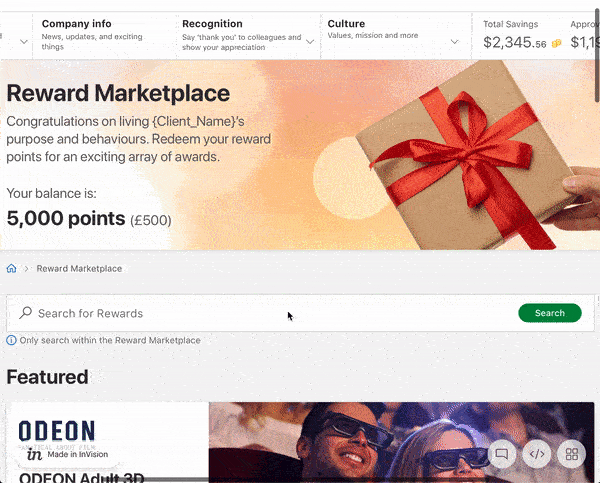The way we reward employees has evolved significantly in the last decade. This is in part because slow wage growth in the U.S. means employers have had to find more innovative ways to build a strong Employee Value Proposition and set themselves apart as preferred employers.
It's also because employee behaviors and expectations have evolved – instead of staying in an organization for decades, the average length of tenure in the U.S. is between 3-5 years.
This means spending the majority of our reward budget on long service or tenure awards doesn’t make sense; most of the talent in your organization is likely to have moved on before hitting a 5-year, let alone 10-year, service milestone.
Our experience working with over 2,500 organizations has proved that the most impactful modern reward and recognition programs focus on recognition first. But that doesn’t mean the “reward” part of R&R doesn’t matter at all.

Why is reward an important component of modern reward and recognition programs?
The programs that successfully improve culture and engagement and deliver a valuable ROI actually pair strategic recognition with well-considered and seamlessly delivered rewards. Research from Josh Bersin on High Impact Performance Management showed that:
Of the organizations that delivered strong financial performance, 57% had a program that contained both a reward and recognition component, compared to 38% of organizations that had recognition-only programs.
This shows us that having some sort of strategic recognition program improves business performance, but you’re more likely to make an impact if you combine reward with recognition.
Diving into different types of reward for employees
If rewarding employees is something new for your organization, you’re not alone. To help, let’s take a look at some common reward ideas that you could provide for employees:
|
Non-Monetary |
Monetary |
|
|
But before you decide what’s best for your business, we recommend two things:
- Consider the timing and relevance of rewards. Research proves that the carrot and stick approach to employee motivation isn’t always best. For more complex or creative tasks, rewards are more impactful if they are unexpected. A “now that that you’ve done this, we’d like to give you….” approach will drive motivation and innovation than the “if you complete X, then you’ll be rewarded with Y” approach.
- Ask your people what they want. Verbal praise, a lunch with the CEO or opportunities for Learning & Development will land differently for the different people in your organization, so it’s best to survey your employees, and, based on their response, offer a variety of different options your people can choose from.
1. Modern employee reward programs offer employees choice
Providing choice is important because giving a reward that doesn’t resonate with the individual can sometimes have the opposite effect on engagement – it can even be seen as insulting or disrespectful. It might be a shirt that’s several sizes too big (or too small!), a bottle of wine for a person who doesn’t drink alcohol, or dinner at a seafood restaurant for someone allergic to shellfish. Too often we hear stories of employees who are on the receiving end of a reward that is impersonal or impractical, and they don’t feel great after the experience!
Modern programs provide rewards that are relevant to the individual. How, when and what we reward our employees with should be respectful and focus on what they value.
Keeping a record of personal preferences isn’t always practical or scalable for large organizations. Many of our clients allocate a dollar value for different company awards in their employee recognition formula or strategy, then give employees the flexibility to redeem those rewards on hundreds of online or physical retailers.
With our reward redemption capabilities, employees can use their reward to purchase a special outfit, a new piece of tech, or book a weekend getaway, they have the freedom and flexibility to do so. They can also choose from countless items with our seamless integration with Amazon.

Giving employees the freedom to choose how they spend their financial reward not only gives them complete autonomy, it also ensures the reward is relevant and valuable for the individual, without the costs of maintaining reward options or stock in-house.
And while this is great for employees, it's also great for HR. Now you can deliver impactful rewards without the hassle (or countless hours) for program administrators. To ensure a best-in-class employee experience, the Reward Marketplace includes a catalog live feed (for up-to-the-moment reward selections), 24/7 employee support, delivery and return management and real-time reporting.
2. Modern rewards can be delivered immediately
Modern reward programs are designed to mirror the on-the-go demands of the modern employee. That means they provide real-time, meaningful and positive recognition of employees who have lived your company values and contributed to achieving your mission. It also means providing immediate, on-the-go redemption of rewards.
When employees have to wait for a reward to be ordered, processed or delivered, you risk losing the shine of the moment. Worse, if the reward is a physical item like a trophy or a toaster, you risk losing the item itself!
Modern reward programs leverage the power of technology to provide instant access to rewards that are relevant, valuable and meaningful.

3. Modern rewards are transparent and true-to-value, and drive a culture of recognition
One of the biggest barriers to implementing a successful modern rewards program is the risk associated with the reward and recognition budget – employers don’t want to see their investment eroded by fees and charges.
Modern rewards programs provide rewards at full face value, giving managers complete visibility and control over the reward budget and the freedom to reward employees whenever they deserve it.
When reward providers involve a commercial model that requires a minimum spend or charges administration, processing or delivery fees each time a reward is given, managers are less driven to give employees timely rewards that they deserve in the moment. This hinders the appetite for timely, on-the-spot reward and recognition.
True-to-value rewards are helpful for two reasons:
- Managers have full visibility of their reward budget: Instead of wondering what reward points translate to in dollars, or whether a $50 reward will actually cost the business $65 after “admin” or “processing” fees, rewards are invoiced as you see them.
- No-one’s getting a clip of the ticket: The value of each reward isn’t diluted. If your employees get a $50 reward, it costs your organization $50 and importantly, the employee receives the full $50.
Having a transparent, easy-to-understand system for managers means they have full control over the costs, so it’s easier to build a culture of reward and recognition.
Has your reward and recognition program evolved to meet the needs and expectations for your modern workforce? Which of the areas above would you work on to drive change and create the positive impact you want for your organization?
If you’d like to learn more about how to design and implement an impactful reward and recognition strategy, contact my team and I for a chat.

 George Dixon
George Dixon



